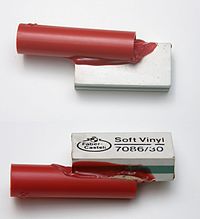
Photo from wikipedia
Mechanical properties and degradation profile are important parameters for the applications of biodegradable polyester such as poly(glycerol sebacate) in biomedical engineering. Here, a strategy is reported to make palmitate functionalized… Click to show full abstract
Mechanical properties and degradation profile are important parameters for the applications of biodegradable polyester such as poly(glycerol sebacate) in biomedical engineering. Here, a strategy is reported to make palmitate functionalized poly(glycerol sebacate) (PPGS) to alter the polymer hydrophobicity, crystallinity, microstructures and thermal properties. The changes of these intrinsic properties impart tunable degradation profiles and mechanical properties to the resultant elastomers depending on the palmitate contents. When the palmitates reach up to 16 mol%, the elastic modulus is tuned from initially 838 ± 55 kPa for the PGS to 333 ± 21 kPa for the PPGS under the same crosslinking conditions. The elastomer undergoes reversible elastic deformations for at least 1000 cycles within 20% strain without failure and shows enhanced elasticity. The polymer degradation is simultaneously inhibited because of the increased hydrophobicity. This strategy is different with other PGS modifications which could form a softer elastomer with less crosslinks but typically lead to a quicker degradation. Because the materials are made from endogenous molecules, they possess good cytocompatibility similar to the PGS control. Although these materials are designed specifically for small arteries, it is expected that they will be useful for other soft tissues too.
Journal Title: Macromolecular bioscience
Year Published: 2020
Link to full text (if available)
Share on Social Media: Sign Up to like & get
recommendations!